Edmund Brookes
October 2011
This history of Trumpington Parish Church is based on a talk by Edmund Brookes, given to the Local History Group in the Church on 13 October 2011. Edmund Brookes is a Churchwarden who had known the Church for over 50 years.
See also the general introduction to the Parish Church. Current information about the Church is available on the Parish Church web site .
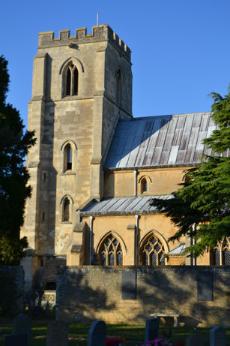
Introduction
Trumpington Parish Church is now dedicated to St Mary and St Michael but was previously known as St Mary and St Nicholas and is referred to by this name on some occasions. We are not sure when the current dedication was adopted. We are truly blessed to be able to worship in such a magnificent building, which is in such a good state of repair.
This paper describes the building, its features and the development of the structure. Any paper about a building so old, beautiful and well documented can only scratch the surface, but my aim is to whet your appetite to look further, to misquote Sir Christopher Wren’s tombstone. There is further information in the sources listed below.
In A Cambridgeshire Village, Edith Carr (1973) makes few references to the Church except that “it played an important part in the lives of mediaeval England” and held vast tracts of land including 500 acres in Trumpington belonging to the Convent at Ely in 991AD. The Bishops of Ely seemed to take a close interest in the area. Carr concludes that no records exist of the earlier church. She quotes Blomefield as saying “rectors presented vicars and in 1389 the nuns of Haliwell presented rectors”. Briefly the difference between a rector and vicar had more real significance in olden times than now. A rector had responsibilities, such as repairing the Chancel, whereas a vicar had not. Of course in the past the pay of vicars was proportionately more than it is now. There was and still is a system of patronage: Trinity College is our patron.
I clearly recall John Tanfield, my celebrated history master at the Perse School and well known Cambridge thespian, stating in our first year, when we studied local history, that Trumpington paid a tax of thousands of eels a year to Ely.
Over the years, especially during and after World War I, the village changed. It was a spectacular example of ribbon development right through to Shelford. The building of Foster Road and Paget Roads after World War II moved the village centre away from the church, so that the church now sits at the edge of the built up area, though that may change. As Christianity as part of the life of this country has changed over the last half century, being on the edge rather than in the community makes our visibility harder to maintain, though the Church stands well as you approach from Harston, more so than from Grantchester, but is scarcely visible from either the Shelford or Cambridge directions. Anyway, we are where we are and this magnificent building remains solid and in good order. When it is safe to do so, there is a very good view from the Tower.
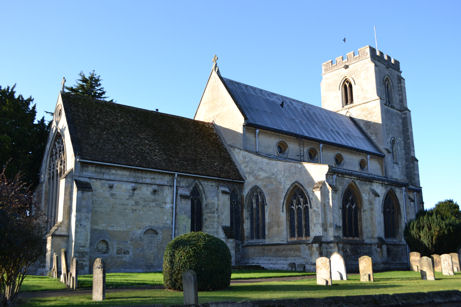
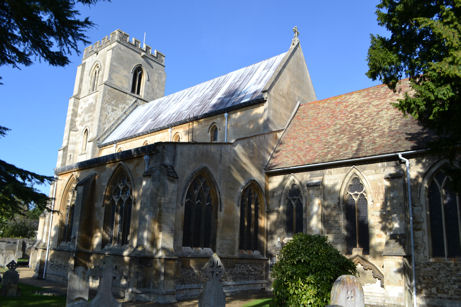
The structure
We do not know how long there has been a church on this site but earnestly believe that there was a wooden Saxon church before the present structure was started. There would have been locally grown timber but no stone to speak of. The Royal Commission on Historical Monuments (1959) refers to the walls being chiefly of Barnack stone, with some Ketton and Ancaster stone, none of it particularly tough, but it has stood the test of time. We can be assured that there has been a stone building on this site for centuries. At the back of the church adjacent to the Vestry door is a record of Rectors and Vicars who have served here, starting with Hendricus (Rector) and Ioce or Jocius (Vicar) in 1220.
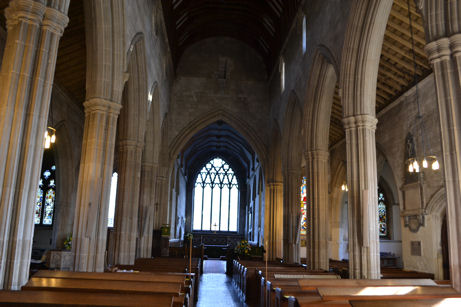
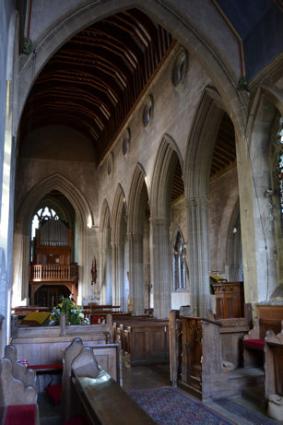
The building is essentially 14th century with the Chancel and Tower being 13th century. There was either an earlier stone Nave, or this was the site of the wooden Saxon church with stone additions to the east and west. It is generally accepted that the earlier Nave was an aisled stone building dating from the late 12th or earlier 13th century, as there are bases at the west end of the South Aisle from that period (Royal Commission on Historical Monuments, 1959).
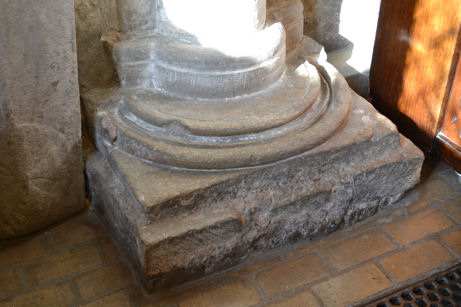
There are few parish churches around here as lofty, wide and so well proportioned and with such slender pillars as St Mary & St Michaels’. In the 1950s, the University’s Department of Architecture used to bring its students here specifically to view them. The pillars are nicely formed and very thin, giving a high but well lit and airy Nave.
The Chancel’s east window contained medieval glass until 1990; though now plain, it is still a magnificent window. The wooden roof is again Medieval; when the Chancel was restored in 1964, specks of the original colours were found under a drab ochre, I think it was limewash. A rapid decision was taken to recreate the colouring and the blue roof was done darker than you now see, so that it naturally faded to its current colours. In addition the spars were picked out. It has fine bosses. It is a false roof and you can see the true line from the Nave and exterior.
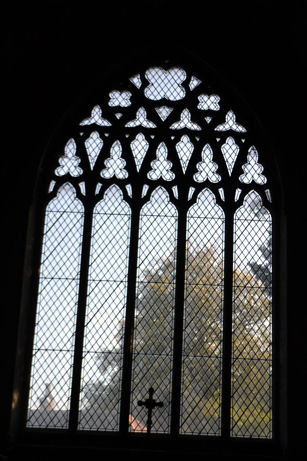
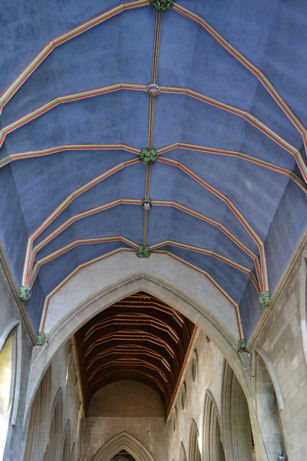
At one time there was a Sacristry off the north side of the Chancel and the internal portico is still apparent. The marble behind the altar is I believe more modern. For years it was covered by a curtain, but under Reverend Thistlethwaite the central block behind the altar (which is actually cement) was given a marbled finish and the curtain removed. It is hard to tell the marble from the marbled. The sanctuary was reordered with a new communion rail courtesy of Lord Baker about 45 years ago in memory of his mother and sister. It is paved with beautiful York stone. Some of the wood panelling is 20th century though the choir stalls are 19th century.
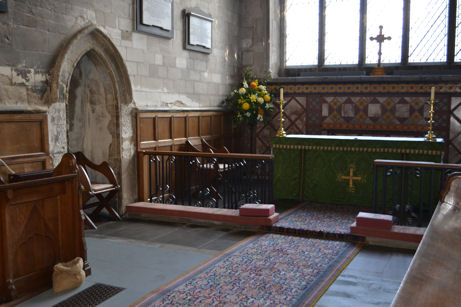
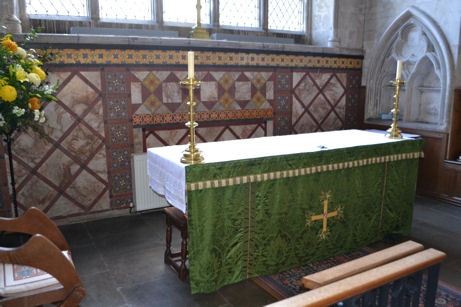
Pevsner (1954) notes the 19th century refurbishments under the celebrated architect William Butterfield. The Nave roof was replaced and lifted by Butterfield when he re-ordered the church in 1876. The basic structure is pitch pine and there was great concern in the 1960s that it was liable to infestation by death-watch beetle which was then prevalent. The Nave was scaffolded at the same time as the Chancel and I went up the scaffolding with my father. Fortunately it was a scare and the timber was treated and the plaster lime-washed. No one has been up since, though it has been closely inspected with binoculars! From this one can conclude that the earlier roof (i.e. 14th century) was high and Butterfield put it back to where it was! A Victorian photograph suggests that the current roof is the third, as it was obviously taken before the present roof was installed by Butterfield.
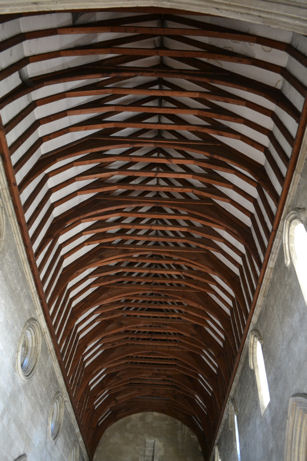
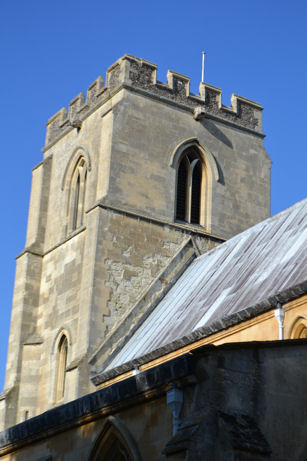
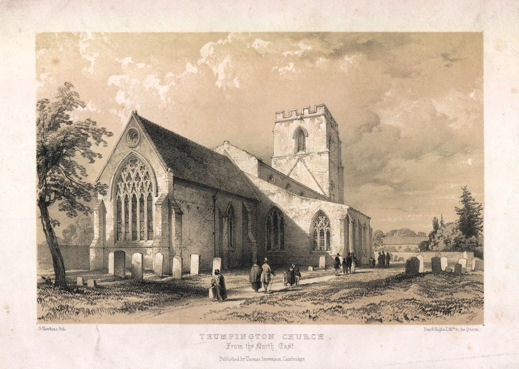
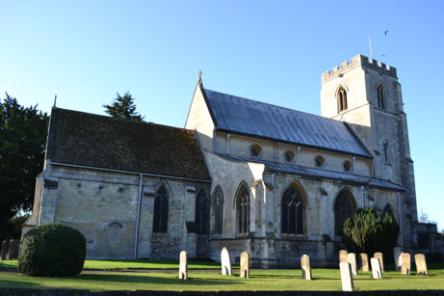
Looking at the Nave stonework you can see where it is the softer Barnack stone, but it will not need replacing for centuries. Butterfield also fitted new pews to replace the rather ancient high and disorderly ones which had rather split up the Nave.
The North and South Chapels are also 13th century. There is a vault under the North Chapel which was inspected about 2001 when the floor was levelled.
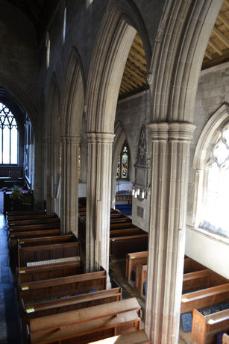
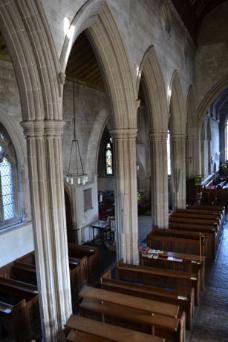
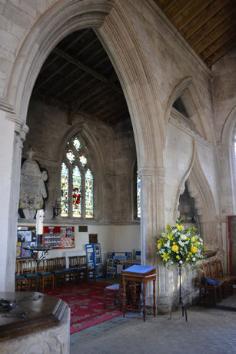
At the west end, the lofty Tower is 13th century with a little 14th century infill in the west wall of the south Aisle. It is in very good order. The north and south porches and Vestry are 19th century.
Outside the roofs are lead covered, with some old scratchings which are illustrated in the books, except the Chancel roof which is tiled. So we conclude that the lead roof is quite old. The Parochial Church Council is aware that at some time in the foreseeable future it will need rerolling, as it is prone to small leaks around the nails which hold the sheets in place.
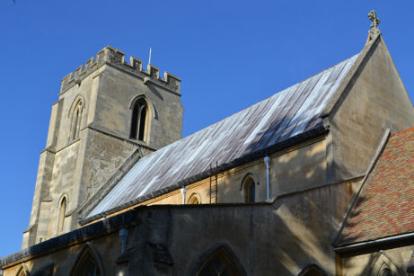
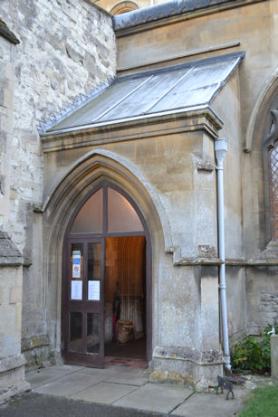
Stained glass
The ancient glass from the central panel of the east window was a collection of pieces which are now in a window below the Fawcett window in the Chancel, in a window above the vicar’s stall or being conserved at the University of York. Some consider it some of the oldest glass in Cambridge. The University of York has recently given the church the result of its studies and we hope to have the remaining glass back suitably conserved. When re-glazed in 1991, stiffening bars/rods were inserted in the East Window and you can just see them if you look closely. It certainly lets the light in, especially at an early morning service with a low sun.
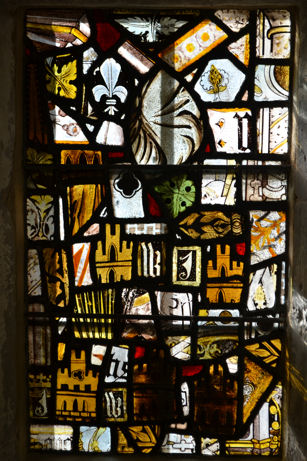
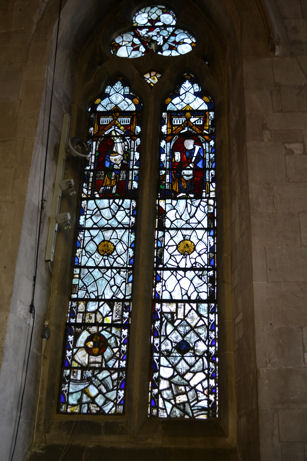
The majority of the remaining stained glass is 19th century with some particularly fine windows. These include the Whit Window in the South Aisle ( The Feeding of the 5000 ) and the Fawcett Memorial in the south wall of the Chancel. The south windows in the South Chapel are modern, and refer to someone still living.
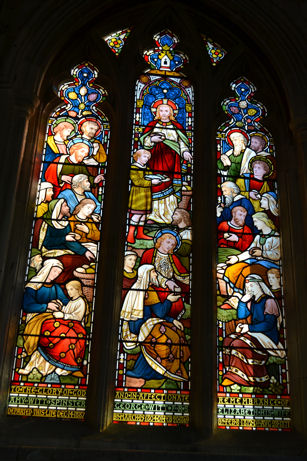
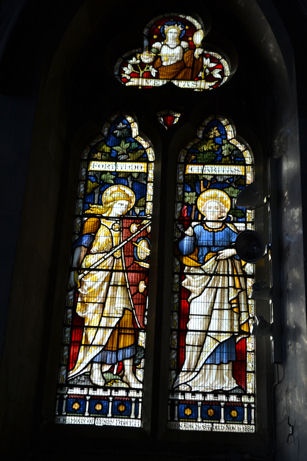
Muniments
With a couple of exceptions, most of the memorials are Victorian. They commemorate the Anstey and Foster families at Anstey Hall and vicars especially the Hailstones. At one time, Trumpington was a home for Trinity Fellows when they married and many then served the parish with distinction. Reverend Hailstone was a notable example who ministered well to the parish for many years and is remembered by a tablet on the Chancel wall, as is his wife. He was in his late 80s when he died and he left some money for charity.
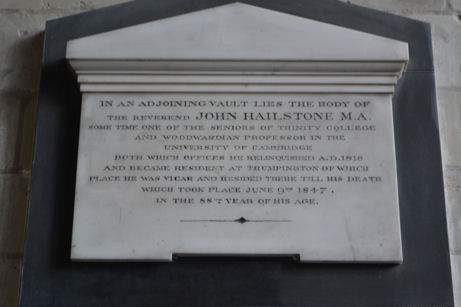
Some of the memorials are to the Pemberton family, especially in the North Chapel. When I first came to Trumpington, this was referred to as the Pemberton Chapel with lateral seats used by the family at Matins. The memorials and window on the north wall commemorate Sir Francis Pemberton, died 1697, Lt Col. Pemberton, died in Bangalore in 1876, and Capt. Pemberton who died early in World War I in Flanders.
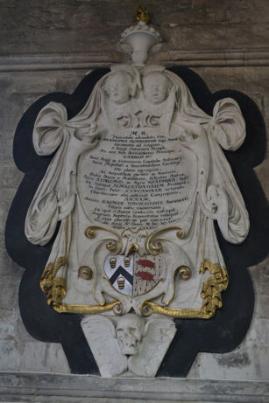
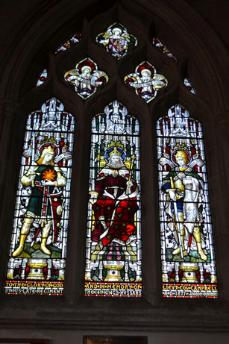
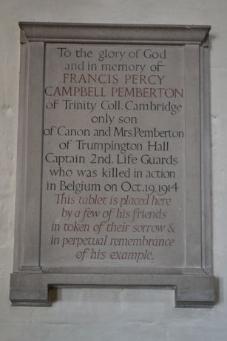
There is no memorial that I know of to either John Overall or William Dakins, vicars of Trumpington in 1592 and 1603, who assisted in the English translation of the bible to produce the King James Bible in 1611.
Exceptional features
The organ, built in 1851by Walkers, was moved to its current location in the 1920s from adjacent to the South Chapel. It is a fine 2 manual instrument with manual action, and has been rebuilt/revoiced several times, lastly in 2003 under the guidance of Harrison & Harrison of Durham. Its supporting oak framework is dedicated to those who lost their lives in World War I and their names are carved under the floor on which the organ rests.
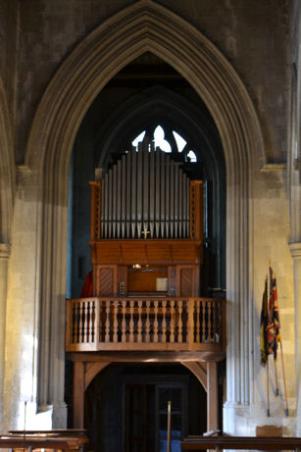
Under the Tower is the stone base of what was probably a wooden Medieval village cross, found when the foundations were being dug for the current War Memorial.

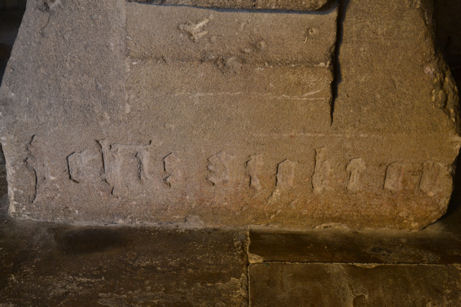
There is a fine peal of 8 bells in the Tower. There were 6 until 1956 when 5 were recast at Loughborough and 3 new ones added, including a new tenor, courtesy of Miss Kitty Willers in memory of her parents and I think Miss Lawrence (her aunt). The Medieval tenor bell was cracked and resided for many years at the base of the Tower. In the early 1990s it was successfully repaired using a modern cold weld technique by the Whitechapel Foundry and re-hung in the Bell Chamber and used as a Sanctus Bell . When the Vicar and Churchwardens went to Loughborough to see the new bells, they overtook Miss Willers on her Scooter when nearly there!
The fine c. 15th century font, probably recut in the 19th century, was moved from under the Tower to adjacent to the main north door in the 1970s.
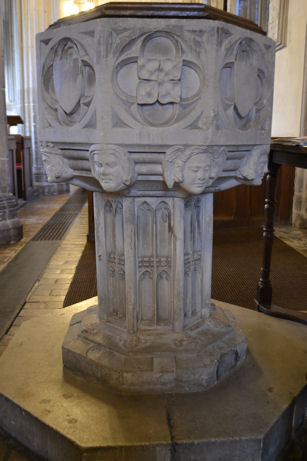
The pulpit came from the Emmanuel College in the 17th century, possibly out of the Old Library. It was returned to a single support in the 1960s.
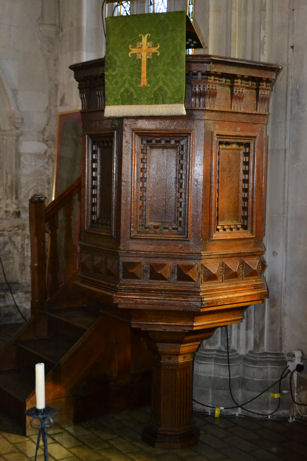
We are fortunate that the base of the Medieval Chancel screen has survived, despite being hacked by Oliver Cromwell’s forces. It could perhaps do with a little refurbishment, but the colours stand out and at least the Vicar in his stall is not now cut off.
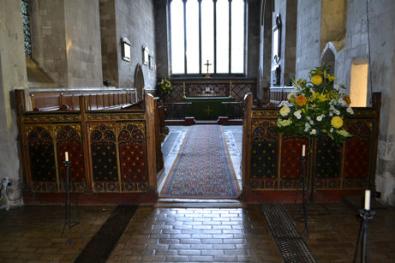
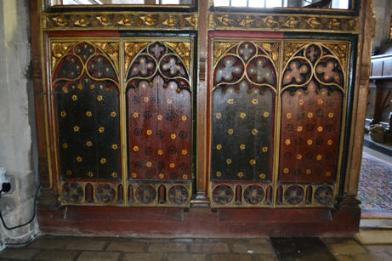
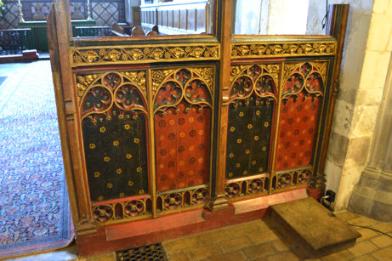
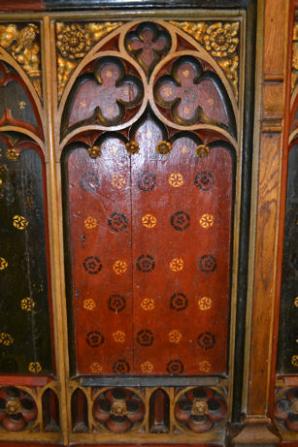
Sir Roger de Trumpington
I have deliberately left our Pride and Joy until the end, the military brass to Sir Roger de Trumpington, which lies on a block of Purbeck marble by the North Chapel. Normally attributed to 1289, Sir Roger was a Crusader and we attribute its survival to it being on a plinth.
It is the second oldest military brass in the country, the oldest being at St Mary’s Church, Stoke d’Abernon, Surrey. When brass rubbing was all the vogue, the income was sufficient to pay the Parish’s quota (the Church tax the Parish paid to the Diocese to cover ministry costs). Not so today. Look at it closely as it is absolutely priceless. There is a particularly fine rubbing beside it which was recently given to the Church from its owner in Sussex.
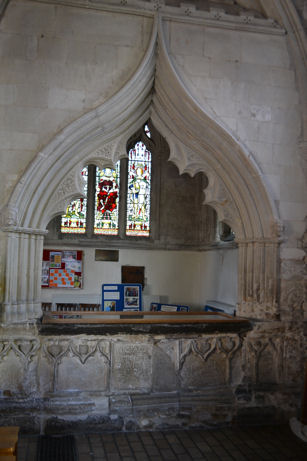
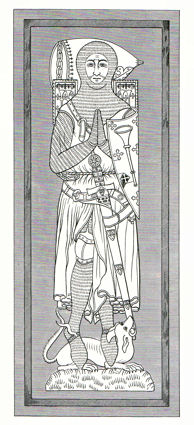
Sources
The Church (2006). St Mary & St Michael Trumpington. Available from the Church, £2 for Church Funds.
The Church (1989). A Brief History of Trumpington Church.
Brookes, Arthur (n.d.). The Parish Church of St Mary & St Michael Trumpington.
Carr, Edith (1968-76). The Story of Trumpington Church. : The Church.
Carr, Edith (1973). ‘Trumpington: A Cambridgeshire Village’. In People and Places. An East Anglian Miscellany. Lavenham: Terence Dalton Ltd.
Cambridge Camden Society (1845). Churches of Cambridgeshire and the Isle of Ely. Cambridge: The Society. Includes chapter on Trumpington Church, pages 33-56 and plates.
Pevsner, Nikolaus (1954 and 1970). Cambridgeshire. The Buildings of England. Harmondsworth: Penguin.
Royal Commission on Historical Monuments (1959). An Inventory of the Historical Monuments in the City of Cambridge. Part II. London: HMSO. Pages 294-98.
Trumpington Local History Group (2003). Trumpington Past & Present. Stroud: Sutton Publishing.
The Victoria History of the Counties of England (1982). A History of Cambridgeshire and the Isle of Ely, Volume VIII. Armingford and Thriplow Hundreds. Edited by C.R. Elrington. Oxford: Oxford University Press for the Institute of Historical Research. Pages 262-65.